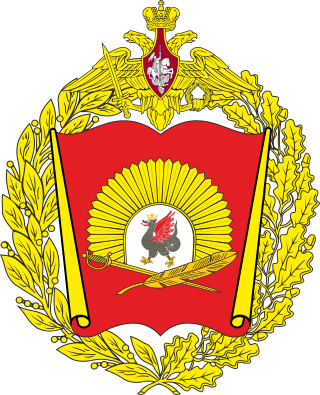
Ivan Stepanovich Konev was a Soviet general and Marshal of the Soviet Union who led Red Army forces on the Eastern Front during World War II, responsible for taking much of Axis-occupied Eastern Europe.

Military districts are formations of a state's armed forces which are responsible for a certain area of territory. They are often more responsible for administrative than operational matters, and in countries with conscript forces, often handle parts of the conscription cycle.

Andrei Antonovich Grechko was a Soviet military commander and Marshal of the Soviet Union during the Cold War. He served as the Soviet Minister of Defence from 1967 to 1976.

Kirill Semyonovich Moskalenko was a Marshal of the Soviet Union. A member of the Soviet Army who fought in both the Russian Civil War and World War II, he later served as Commander in Chief of Strategic Missile Forces.

The Russian Ground Forces, also known as the Russian Army, are the land forces of the Russian Armed Forces.
In warfare, a theater or theatre is an area in which important military events occur or are in progress. A theater can include the entirety of the airspace, land and sea area that is or that may potentially become involved in war operations.

The Soviet Armed Forces, also known as the Armed Forces of the Soviet Union, the Red Army (1918–1946) and the Soviet Army (1946–1991), were the armed forces of the Russian SFSR (1917–1922) and the Soviet Union (1922–1991) from their beginnings in the Russian Civil War of 1917–1923 to the collapse of the USSR in 1991. In May 1992, Russian President Boris Yeltsin issued decrees forming the Russian Armed Forces, which subsumed much of the Soviet Armed Forces. Multiple sections of the former Soviet Armed Forces in the other, smaller Soviet republics gradually came under those republics' control.

Sergei Alexandrovich Khudyakov ; (born Armenak Artemi Khanferiants, was a Soviet Armenian Marshal of the aviation.

The Baltic Military District was a military district of the Soviet armed forces in the Baltic states, formed shortly before the German invasion during World War II. After the end of the war the Kaliningrad Oblast was added to the District's control in 1946, and the territory of Estonia was transferred back to the Baltic Military District from the Leningrad Military District in 1956. The Baltic Military District was disbanded after the fall of the Soviet Union in 1991 and reorganised into the North Western Group of Forces, which ceased to exist following the withdrawal of all Russian troops from Estonia, Latvia and Lithuania on 1 September 1994.
The Soviet Ground Forces, successor to the Red Army, the title changing in 1945, employed a wide range of different military formations.

The Transbaikal Military District was a military district of first the Soviet Armed Forces and then the Armed Forces of the Russian Federation, formed on 17 May 1935 and included the Buryat Republic, Chita Oblast, and Yakutia. Chita was the headquarters of the district. It was finally disbanded on 1 December 1998 by being amalgamated with the Siberian Military District, though Chita remained the headquarters of the new amalgamated district.

The Ground Forces of the Armed Forces of the Soviet Union was the land warfare service branch of the Soviet Armed Forces from 1946 to 1992. In English it was often referred to as the Soviet Army.

Georgiy Fedorovich Zakharov was a Soviet general who served in World War I, the Russian Civil War, and World War II.

The 392nd Hero of the Soviet Union Marshal of the Soviet Union V. I. Petrov Pacific Red Banner Order of Kutuzov District Training Center is a training formation of the Russian Ground Forces. It is located at Knyaze-Volkonskoye in the Khabarovsk area.

Aleksandr Nikolayevich Postnikov-Streltsov is the former commander-in-chief of the Russian Ground Forces (2010–2012). He currently holds the rank of Colonel General.

Mykhailo Mykolayovych Kutsyn is a former Chief of the General Staff and Commander-in-Chief of the Armed Forces of Ukraine. He was appointed Chief of the General Staff by acting president Oleksandr Turchynov on 28 February 2014. Kutsyn was relieved of this post by president Petro Poroshenko on 3 July 2014. Poroshenko thanked Kutsyn for his service and stated he had been shell-shocked on 2 July 2014 while combating the 2014 insurgency in Donbass. He had suffered a concussion and was recovering at a hospital.

Aleksey Semenovich Zhadov, born with the surname "Zhidov", was a Soviet military officer in the Red Army, who during World War II commanded the 66th Army, later renamed the 5th Guards Army, from the Battle of Stalingrad up till the end of the war. For his leadership of the army, Zhadov was awarded the title Hero of the Soviet Union. Postwar, Zhadov commanded the Central Group of Forces and was deputy commander of the Soviet Ground Forces.

August Ivanovich Kork was an Estonian Red Army commander who was tried and executed during the Great Purge in 1937.

Ivan Mikhailovich Chistyakov was a Soviet Army colonel general and a Hero of the Soviet Union.

The Kazan Suvorov Military School (KzSVU) is a Russian military academy based in Tatarstan. It serves as one of the country's many Suvorov Military Schools funded by the Russian Armed Forces. It is currently decorated with the Order of the Red Banner.
















